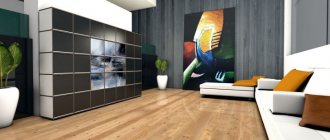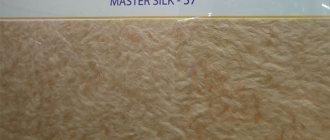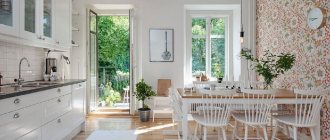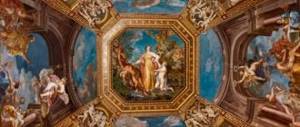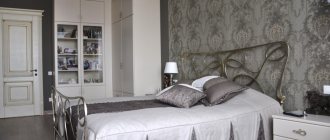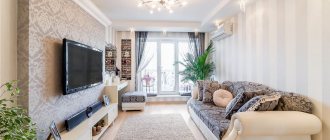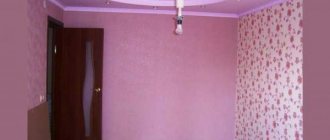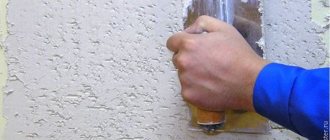Liquid wallpaper Paintings from them, the design of which is not so complicated, will emphasize the individuality of each room and allow you to realize the most extraordinary ideas. We create paintings for the interior from liquid wallpaper: technology, design, general recommendations
You can create a wide variety of pictures from liquid wallpaper: your home will become unique. In the modern world there is a huge selection of wall decoration and decoration. Combining wallpaper is one of the most popular Western trends, which is a simple and affordable way to decorate. By combining wallpaper of different textures and colors, using liquid wallpaper, you can transform the interior and create an accent in any room.
Wallpaper paintings in the interior: variety and practicality
The paintings themselves are an independent decoration in the room and create additional comfort if stylistically chosen correctly. Using the remnants of wallpaper that remain after all the finishing work, you can create original design solutions yourself: framed paintings, modular paintings, panels, false panels, patchwork paintings in the patchwork style
Drawings with liquid paintings on wallpaper are becoming quite popular: they can be applied even to an imperfectly flat wall
Wallpaper decor allows you to solve a number of functional problems:
- Hide wall defects and layout flaws (visually expand a small room, change the proportional ratio of the width and height of the wall, smooth out the effect of too high ceilings);
- Divide the space into functional zones (relevant for studio layout);
- Create a general concept for the entire room without losing the individuality of each individual room;
- Break up the monotony and highlight the main walls artistically.
Pictures framed from wallpaper
The technique is simple to implement: the wallpaper is pasted onto hard cardboard and framed using a strip, plinth, or molding (an overlay convex strip for decorating surfaces). The main nuance: wallpaper paintings should be consistent in color with the decor of the room. Paintings with expressive designs - bright colors, geometric shapes, elegant patterns - look most advantageous.
Wallpaper panel
Such paintings differ from previous ones only in the absence of a frame. When performing work, the wallpaper is glued to a panel (cardboard, plywood, chipboard) with an allowance so that the edges are turned to the reverse side.
If you want your interior to look modern and stylish, then panels with 3D wallpaper are suitable for you.
To imitate the 3D Wallpaper technique (3D wallpaper), a panel is created from the same wallpaper that decorates the entire wall.
False panels
To change the design of the room without resorting to major renovations, you can decorate the walls with new wallpaper panels. It is enough to paste the wallpaper segments onto the old finish and, after drying, highlight the borders with frames. New “panels” only occupy part of the wall, so they must be consistent with the main wallpaper and the overall style of the room.
Lovers of the bright and extraordinary can use the patchwork technique (patchwork finishing in sewing, which can be used for interior decoration).
The patchwork method is an original way to decorate your home: in addition, wallpaper created using this method has a fairly low cost
Using leftover wallpaper in the form of appliqués, paintings, decorative elements, and patchwork walls are created. A children's room can be an excellent platform for creativity in the patchwork style. For example, create fragments of fairy tales or cut out circles of different diameters from wallpaper and chaotically glue them onto the main wall decoration and get a room with polka dots.
According to statistics, most people in quarantine hang out on the Internet. Most people have fun by organizing all sorts of virtual parties. But many still spend time online mainly usefully - studying, taking online excursions to museums and attractions around the world. And those lucky ones who can keep themselves busy without getting involved in the World Wide Web, and at the same time invest their work in the future, decided to renovate! Yes, yes, and not only in the apartment, but also in country houses, a characteristic noise is heard every now and then. Even if current conditions do not allow for global changes, a “cosmetic renovation” is quite possible.
The artist reproduces the icon of the Mother of God on the wall using Silk Plaster liquid wallpaper
Lera Kudryavtseva, Prokhor Chaliapin, Natalia Gulkina and singer Aziza decided to renovate their homes for the summer. And with them are millions of Russians, confident that quarantine is the best time for repairs. Moreover, today there are enough modern materials with which you can decorate walls, firstly, without harm to health, and secondly, beautifully and fashionably. A new trend in renovation is paintings and frescoes made from liquid wallpaper. Master from Penza, Mikhail Zubakov, says that more and more often landscapes, portraits and still lifes made from decorative silk plaster Silk Plaster are ordered from his company.
“The work is done differently,” says Mikhail. – Our masters - Oleg Motorin, Mikhail Efimov, Svetlana Resyaeva make various frescoes and paintings from Silk Plaster liquid wallpaper. Each work is interesting in its own way and has its own history.
Paintings painted with liquid wallpaper
“This year we wanted to implement a special creative project. Over the past year, our artist Natalya Arkhipova has been gaining experience in various painting techniques for applying liquid wallpaper. And there was a plan for Easter to open an exhibition of 28-30 works by her on the Easter theme, and not only. I wanted to show all the possibilities of a material that is unusual for painters and graphic artists, its warmth, texture, and color solutions. But the virus intervened and the projects had to be suspended. But you always want to look into the future with hope and faith. There are still plans to organize master classes on the artistic application of frescoes. Today we are exploring the possibility of doing this remotely via the Internet.
An exhibition of Easter-themed works had to be postponed
Let us add that you can apply liquid wallpaper to walls even with children. They are hypoallergenic and absolutely safe for health. You can try to create a picture for all household members together. And if your young artists make a mistake, it can always be corrected - liquid wallpaper can be easily repaired. So, updating your home can be a fun and rewarding activity for the whole family.
This painting will make your home unique
Share link:
- Click to share on Twitter (Opens in new window)
- Click here to share content on Facebook. (Opens in a new window)
Similar
Similar
Myrtesen
News advert.mirtesen.ru
Modular paintings: a current decorative element
Modular paintings are a whole composition that is divided into several paintings (panels), united by one concept, color scheme or general sketch. In other words, it's one big picture divided into segments.
Modular paintings can be created from leftover wallpaper
There are many variations in the design of modular paintings:
- Modular compositions can include from two paintings to infinity;
- The size of the segments is created either of the same size or different;
- The paintings are placed on the same level or randomly.
This is a very impressive interior detail, so most often modular paintings are hung on empty plain walls so that extraneous details do not distract attention from the composition.
Liquid wallpaper styles
The modern interior decoration options offered will fit perfectly into any style composition, because there are numerous types of liquid wallpaper, and the photos confirm this fact perfectly.
Liquid wallpaper of a pleasant heavenly color will create an atmosphere of lightness and comfort in the room.
Living room in warm colors. The walls were decorated with a combination of liquid and regular wallpaper.
Decorating the living room and fireplace with liquid wallpaper in a pleasant sand color
Liquid wallpaper and decorative stone are widely used in the interior, and they can also be combined with other finishing options.
It is important to know! Such materials are ideal for decorating rooms in the style of different countries. Roman, Greek, Spanish, Brazilian - all this will certainly delight you with the richness of the color palette.
Do-it-yourself paintings from leftover wallpaper: execution technology
It’s quite easy to create paintings from wallpaper yourself. We carefully think through all the details of the composition so that the painting fits harmoniously into the interior.
Plywood sheet is the most durable base for paintings
Basic stylistic rules for combining wallpaper:
- It is best to select wallpapers of the same quality, which differ in color, texture and composition.
- To avoid uneven joints and problems with framing, the thickness of the wallpaper should be approximately the same.
- Wallpaper compositions are selected to match the style of the room or are correlated with individual interior details (a combination of shades of different colors, general patterns and ornaments, bright colors that complement each other in contrast, geometric shapes combined with abstraction).
Next, we select any dense base onto which we carefully glue the wallpaper composition. The base can be hard cardboard, chipboard, or polystyrene foam (bulk foam sheets are perfect for creating panels and modular paintings). Using available tools: scissors, glue, stencils and pins, we create a picture.
It is worth paying attention to the fastening. Depending on the weight, desired design, and intended mobility of the painting, fastening brackets, double-sided tape, liquid nails, hooks glued to the wall, polymer glue or the Command system (Velcro for the wall and painting) are used.
Backgrounds for paintings
Each of my paintings is unique in its own way. In addition to traditional painting (watercolor, gouache), in my gallery you can see paintings created from various materials . This includes paper, shells, and all kinds of cereals. Read more about this in the article “Unusual Paintings”.
I try to use different backgrounds for each piece of art I make. Let's talk about them in more detail.
wallpaper can be an excellent background for paintings made from twisted paper (Quilling) ! After repairs, wallpaper scraps usually remain. Don't throw them away! Even if you don't know how to draw, you have the opportunity to make an interesting picture from wallpaper alone. Insert three pieces of wallpaper (preferably with a pattern) into three frames of the same size, and hang them side by side in the form of a triptych.
Liquid wallpaper has become a real find for me . This material opens up truly limitless scope for creativity! In general, if anyone doesn’t know, liquid wallpaper is a modern finishing material that bears little resemblance to traditional wallpaper. This is a dry mixture consisting of several components: most often cellulose, cotton or silk fibers, an adhesive composition and various additives (dyes, multi-colored sequins, threads, etc.). This mixture must be diluted with water and used for its intended purpose - to cover walls and ceilings.
Of course, I couldn’t help but use this wonderful material in my creativity! I first cover the base for the picture (mine is fiberboard) with wood putty (this is necessary so that the wallpaper does not turn yellow), and then with the liquid wallpaper itself. And on top I glue the picture itself. Pay attention to the photo: the background of the painting and the wallpaper on the wall are the same! It looks very advantageous in the interior.
3. It’s not at all difficult to draw a background using dry pastels. For example, during this painting I used pastels. I simply “painted” it in the right places with a pastel pencil, and then rubbed it all in with my finger. As a result, the pencil strokes are practically invisible, and the background turns out to be very delicate. It is not necessary to make the background monochromatic. You can use two or three colors, it depends on your skill and the subject of the picture.
4. A light, airy background is made using watercolors . Floral quilling patterns go well with watercolor landscapes. And if you are not strong in painting, you will be quite capable of making an abstract background . I will describe to you three ways to make such a background.
o The first method is called “ spraying ”. First, you cover a sheet of paper with paint in one layer. A brush should be chosen with stiff bristles and preferably larger. Or you can replace it with an old toothbrush. So, then you put a contrasting color of paint on your brush or brush and use your thumb to splatter it onto the paper. They fly in different directions, creating a unique pattern. You can brighten up the background by using splashes of multiple colors.
o The second way is to create an abstraction using the “ raw on raw ” method. This is a well-known watercolor technique where paints are mixed directly on paper to create interesting patterns.
o And the third way is to use a sponge. Cover a blank sheet of paper with sponge prints by dipping it into paint.
5. An interesting background could be... ceiling tiles ! If the picture is square in shape, and let’s say there is a white background, you can simply “take” the tile into a frame and stick, for example, quilling products on top.
6. You can use a beautiful fabric . Against such a background, delicate, sophisticated works, such as flowers, look good.
7. And finally, I will offer you one more non-standard option. Cut two different colors of paper into strips and then weave them together as shown in the picture. weave looks very good in pastel colors.
So, now you can make as many as 7 paintings with different backgrounds! To be continued
Spectacular do-it-yourself paintings from liquid wallpaper
Finishing material such as liquid wallpaper is becoming increasingly popular.
This is the final decorative coating for walls and ceilings, which has a number of advantages over rolled wallpaper and decorative plaster.
The highest quality wall decoration - relief paintings from liquid wallpaper
- Liquid wallpaper does not form joints when applied;
- Level walls and hide flaws;
- Eco-friendly, with high sound insulation;
- They can be repeatedly transferred to other walls without losing their qualities.
However, liquid wallpaper has a long drying time (up to two days after application).
Liquid wallpaper is a material that allows you to create paintings, panels and paint walls. This is a labor-intensive process, but we can do it ourselves.
How to make a picture using liquid wallpaper:
- Prepare the walls according to the wallpaper instructions;
- Draw the outline of the sketch on the wall in a convenient way (with a pencil, through a stencil, using glass and a lamp);
- Dilute liquid wallpaper to the desired consistency (colors are added to create the desired shade);
- Using a spatula, apply the mixture up to 2 mm thick onto the corresponding segment of the pattern, forming boundaries;
- Allow the pattern fragment to dry completely (the mixture of different colors should not touch each other if the pattern has clear outlines);
- After all the fragments have been processed with the mixture, adjust all parts of the picture using pencils or felt-tip pens.
Liquid wallpaper allows you to individually design your interior, be it a nursery, hallway or kitchen.
Liquid wallpaper - what is it ↑
Liquid wallpaper consists of textile and cellulose fibers mixed with adhesive, dye and various decorative inclusions. The texture and relief of the coating depend on the quality of the fibrous base; the remaining components (except for glue) are designed only for the visual effect.
Kitchen wall decoration
Wall and ceiling finishing
Variety of colors and textures
On a note! Many people confuse liquid wallpaper with decorative plaster, but despite some external similarities, these materials have significant differences in composition and application. Decorative plaster is made on the basis of mineral chips, so it hardens faster and requires skill in work (the entire surface must be covered with an even layer, otherwise joints may be visible). Liquid wallpaper can be made even from old wallpaper; thanks to the soft fibers, they are more pleasant to the touch and even a beginner can work with them.
Types of liquid wallpaper for walls ↑
Depending on the composition of the base, the following types of coatings are distinguished:
- Silk ones are the most expensive and most spectacular. In their production, both natural and artificial threads are used, thanks to which the coating does not fade in the sun and retains its original appearance for up to 15 years.
- Silk-cellulose - made from a mixture of silk and cellulose (for example, cotton fiber or paper). The performance characteristics, of course, are an order of magnitude worse than those of pure silk, but the price is also lower.
- Cellulose is a budget-friendly type of coating due to the availability and low strength of the base. They may fade from exposure to ultraviolet radiation, so they require additional processing.
Liquid wallpaper with a silk tapestry effect
Ceiling decor
For the adhesive composition, special mixtures are used, which are also used for installing wallpaper - each manufacturer has its own recipe, selected for the type of base fiber.
The following inclusions are popular as decorative additives:
- mineral - mica, stone (marble, quartz) chips, coral sand;
- vegetable - algae, wood shavings;
- decorative - sparkles, beads, rhinestones, mother-of-pearl, gold and silver threads, tinsel.
Glitter for liquid wallpaper
Only water-soluble dyes are used, since the dry mixture is diluted with water.
Advice! Think in advance which texture will most successfully fit into the interior of your apartment. The liquid coating may look like silk tapestry, decorative plaster or papier-mâché on the wall.
Estimated characteristics of the material ↑
This type of coating has become so popular among consumers not only because of its decorative qualities, because there are many materials that can easily compete with it in terms of variety of textures and colors. The main advantages of liquid wallpaper are completely different properties.
- Environmental friendliness - the coating is based only on natural materials, which means you don’t have to worry about the harmful effects of their effects and various fumes. They do not cause allergies or other irritations either when touched or inhaled.
- Safety (including fire) - liquid wallpaper of the KMZ class can be used even in rooms where there is a high density of people.
- Good heat and sound insulation - the coating creates an additional layer that prevents the passage of sounds and retains heat in living spaces.
- Elasticity - wallpaper retains its integrity both during temperature changes and during minor deformations of the load-bearing surface (for example, when a new building shrinks).
- Vapor permeability - the coating is called “breathable”, as it freely allows air molecules to pass through. Because of this, the walls do not become damp - a small amount of moisture easily evaporates through the wallpaper, which prevents fungi and other harmful flora from developing.
- Antistatic – the material has a pronounced dust-repellent effect, which allows you to avoid frequent cleaning. This property is especially appreciated when decorating rooms for children and allergy sufferers.
Liquid wallpaper is environmentally friendly, beautiful and pleasant to the touch
In addition, liquid wallpaper also has utilitarian advantages:
- Even a person who has taken on repairs for the first time can do the installation themselves - dilute the composition with water and level the resulting mass on the wall. Even the experts say that you can adapt to the application technology in literally 10-15 minutes.
- Liquid wallpaper is suitable for finishing various non-standard elements (corners, protrusions, door and window jambs).
- To create a smooth, beautiful surface, it is not necessary to thoroughly process the surfaces before applying wallpaper. Defects in walls and ceilings up to 3 mm are perfectly covered by the material itself.
- Contaminated or damaged areas of wallpaper can be removed and replaced with a new layer.
Despite such an abundance of advantages, liquid wallpaper also has disadvantages. First of all, the price. High-quality silk coating costs a lot, especially in comparison with alternative types - paper or vinyl materials. But this drawback can be circumvented if you make liquid wallpaper for the walls with your own hands. The second disadvantage is “hydrophobia”: from constant exposure to moisture, the coating can get wet, delaminate or fall off.
On a note! In rooms with high humidity, you can treat the coating with a finishing layer of varnish (preferably vapor-permeable to maintain the “breathable” effect). But if the neighbors cause a flood, this will not save you from new repairs.
How to apply liquid wallpaper to a wall (video)
Before using liquid wallpaper or remnants of rolled wallpaper, it is worth understanding what accents your interior lacks: bright colors or sophisticated details, consistency between furniture and walls, or new images. All this can be done independently at minimal cost, using the ideas discussed.
How to make modular paintings with your own hands from photo wallpaper
Where to start if you want to make a drawing with liquid wallpaper on the wall
To make a drawing with liquid wallpaper with your own hands, and not resort to the help of specialists, you must first prepare.
First, you need to come up with a sample drawing or find it on the Internet , it can be a geometric figure, a photo, or any image, the choice is limited only by your imagination.
Secondly, you need to decide how many colors you will paint the wallpaper . The easiest option is two colors; the more small fragments, the more difficult the work will be. Pre-count the number of colors used, this will determine how much material you need to buy.
And lastly, decide what type of application will be applied: smooth or voluminous .
